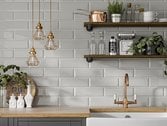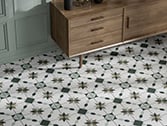Laminate Flooring
- Page 1: Laminate Flooring - Introduction
- Page 2: Laminate Flooring - Before you start
- Page 3: Laminate Flooring - Fitting twinclic
- Page 4: Laminate Flooring - Fitting 1clic2go
- Page 5: Laminate Flooring - Maintenance
- Page 6: Laminate Flooring - FAQs
- Back to Buying Guide
Laminate Flooring - Fitting 1clic2go
Ensure you always read through the fitting instructions found within the pack before starting. Precisely follow the instructions, in order to retain full warranty and guarantee claims.
Preparation
- 1) Store unopened packs in the room to be laid for 48 hours to acclimatise.
- 2) Prepare all tools and underlay.
- 3) Any unevenness in the sub-floor of more than 2mm over 1m must be evened out.
- 4) Check for visual damage to the panels, as once laid no claims can be made.
- 5) The floor must be installed floating, do not glue, nail or screw the floor down.
- 6) Do not lay on carpet, remove before fitting.
- 7) If laying over a stone/mineral sub floor, lay a Damp Proof Membrane (DPM); for enhanced noise reduction use a special absorption product or underlay.
- 8) Under floor heating can be used, to a maximum of 27°C.
Laying
- 9) For best results lay floor in the direction of the light source.
- 10) Begin installing in a corner with the tongue against the wall using spacers to maintain a 10-12mm expansion gap.
- 11) Lay the next panel short side tongue over groove and using a downward action push the tongue of the one panel down into the other panel’s groove.
- 12) Listen for the Click! The boards are connected. Continue to complete first row. Ensure the panels are perfectly in line.
- 13) For ease of measuring rotate the last panel 180°, offer up to space (keep expansion gap), mark & cut.
- 14) Rotate the cut piece and lay as before (12/13).
- 15) Begin the next row using the off-cut from the end of the previous row. Fold the long edge profile (tongue) down into the previous row (groove) at a 45° angle.
- 16/17/18) Continue to install next panel folding the long edge in, then sliding the panel up to meet the previous panel, clicking the short edge in as you fold down. Use the long edge of the previous row as a straight edge guide to ensure alignment.
- 19) Continue this process to lay the entire room.
- 20) If the floor exceeds 8m x 8m expansion breaks in the floor are required – use relevant profiles.
Tips & Tricks
- 21) When cutting around heating pipes, place the panel in line both in front and along side to ascertain accurate marks. Include an additional 30mm on top of the pipe diameter for expansion.
- 22) Use a hole saw for accurate cutting then cut the panel across the short edge through the centre of the hole.
- 23) Fit the large piece as normal, and then insert the smaller piece gluing contact areas to hold in place. If space is at a premium, and you are unable to fold down, trim the profile flush using a wood chisel and glue in place.
- 24) To fit the floor neatly around door frames and architraves, turn over a panel, offer up to the frame to use as a thickness guide. Using a handsaw flush with the underside of the panel, cut the frame/architrave, and, remove the cut piece.
- 25) Slide the panel under the frame, not forgetting to leave room for expansion.
- 26) When measuring the width for the final row, rotate the panel 180° so the tongue faces the wall, not forgetting space for expansion gaps. Once the panel is cut, lay as normal. The space left for expansion will also allow space to fold the panels down.
Care & Cleaning
- 27) Use a soft brush or vacuum cleaner to remove any surface dust. Do not use abrasive cleaners, steel wool or scouring pads, as they will damage your floor.
- 28) For regular cleaning use a cloth, ensuring it is well wrung, it is important not to apply excess moisture to the floor.
- 29) We recommend protecting your floor – use felt pads under furniture. We do not recommend steam cleaning this product or using any polishes or chemicals that may damage the laminate surface. Moveable furniture/chairs should be on soft castors or placed on a plastic mat. Furthermore, any single piece of furniture placed on the floor should not exceed 115kg in weight. Doormats should be used inside and outside of all external doorways to prevent grit from being carried across the floor, protecting the surfaces from excessive wear and tear.











































